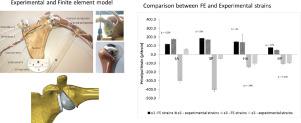Computer Methods and Programs in Biomedicine ( IF 4.9 ) Pub Date : 2021-05-08 , DOI: 10.1016/j.cmpb.2021.106158 M Bola 1 , J A Simões 2 , A Ramos 1

|
Background Replicating a total shoulder arthroplasty in laboratory is a difficult task due to complex geometry of the structures and degrees of freedom of the joint. Implanted joint shoulders have been investigated using numerical tools, but models developed lack of experimental validation. The objective of this study was to develop a finite element model that replicated correctly an experimental simulator of an implanted joint shoulder based on the comparison of measured and calculated strains. The methods used include a non-cemented Anatomical Comprehensive© Total Shoulder System that was implanted in 4th generation composite bones. The finite element model designed replicates adequately the experimental model. Both models included the most important muscles of shoulder abduction and the same boundary conditions (loads, fixation, and interface conditions). Strain gauge rosettes were used to measure strain responses on the shoulder in 90° abduction. The results of linear regression analysis between numerical and experimental results present a high correlation coefficient of 0.945 and a root-mean-square-error of 35 µε, suggesting adequate agreement between the experimental and the numerical models. Small strains were obtained and changes in load distribution from posterior to anterior region were observed. As conclusion we can say that the experiments allowed good replication of the finite element model, and the use of strain gauges is suitable for numerical-experimental validation of bone joints.
中文翻译:

全植入肩关节的有限元建模和实验验证
背景由于结构的复杂几何形状和关节的自由度,在实验室中复制全肩关节置换术是一项艰巨的任务。已使用数值工具对植入的关节肩进行了研究,但开发的模型缺乏实验验证。本研究的目的是开发一个有限元模型,该模型基于测量应变和计算应变的比较,正确复制植入关节肩的实验模拟器。所使用的方法包括在第4生成复合骨骼。设计的有限元模型充分复制了实验模型。两种模型都包括肩外展最重要的肌肉和相同的边界条件(载荷、固定和界面条件)。应变仪玫瑰花结用于测量肩部 90° 外展时的应变反应。该结果数值模拟和实验结果之间的线性回归分析的呈现的0.945的高相关性系数和35με的根均方误差,这表明实验和数值模型之间适当的协议。获得了小应变,并观察到了从后部到前部区域的载荷分布变化。作为结论 我们可以说这些实验可以很好地复制有限元模型,并且应变计的使用适用于骨关节的数值实验验证。











































 京公网安备 11010802027423号
京公网安备 11010802027423号